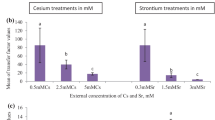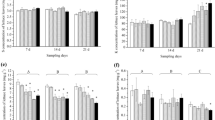Abstract
The artificial radionuclide 90Sr is the main radionuclide in radioactive environmental pollution. In this study, celery was cultured in a laboratory hydroponics system for 21 days with strontium (Sr) levels of 0 (control), 0.5, 1, 2.5, 5, and 10 mM. The changes in the Sr contents in celery leaves and roots as well as the translocation factor (TF) values (ratio of the Sr concentration in aerial plant parts to that in roots) under different Sr concentrations were studied. Additionally, the effects of Sr stress on the absorption of six nutrients, the chlorophyll content, and the biomass of the celery were investigated. The results showed that the Sr contents in celery leaves and roots increased with the increasing Sr concentration in the hydroponic solution, but the increase of the Sr concentration in roots slowed under the 10 mM Sr treatment. The mean TF values ranged from 0.40 ± 0.01 to 1.12 ± 0.17. With the increase in Sr concentration in the hydroponic medium, the contents of calcium, iron, and potassium in the celery leaves were significantly reduced, and the absorption of calcium, iron, and magnesium by roots was significantly inhibited. Compared with the control, sulfur concentration in celery roots increased significantly under the Sr treatments increasing except the 10 mM Sr treatment. The changes in chlorophyll content were consistent with those of celery biomass, and the values of both these parameters were high under the 5 mM Sr treatment.




Similar content being viewed by others
References
Al Attar, L., Al-Oudat, M., Safia, B., & Ghani, B. A. (2016). Ageing impact on the transfer factor of Cs-137 and Sr-90 to lettuce and winter wheat. Journal of Environmental Radioactivity, 164(11), 19–25.
Burger, A., & Lichtscheidl, I. (2019). Strontium in the environment: review about reactions of plants towards stable and radioactive strontium isotopes. Science of the Total Environment, 653(2), 1458–1512.
Burger, A., Weidinger, M., Adlassnig, W., Puschenreiter, M., & Lichtscheidl, I. (2019). Response of Arabidopsis halleri to cesium and strontium in hydroponics: extraction potential and effects on morphology and physiology. Ecotoxicology and Environmental Safety, 184(11), 109625.
Cao, Y., Zhang, Y., Ma, C., Li, H., Zhang, J., & Chen, G. (2018). Growth, physiological responses, and copper accumulation in seven willow species exposed to Cu-a hydroponic experiment. Environmental Science and Pollution Research, 25(7), 19875–19886.
Chen, M., Tang, Y. L., Ao, J., & Wang, D. (2012). Effects of strontium on photosynthetic characteristics of oilseed rape seedlings. Russian Journal of Plant Physiology, 59(6), 772–780.
Cobbett, C., & Goldsbrough, P. (2002). Phytochelatins and metallothioneins: roles in heavy metal detoxification and homeostasis. Annual Review of Plant Biology, 53(6), 159–182.
Ding, K., Liu, S., He, Y., Yan, D., Zhang, F., Wang, S., et al. (2016). Simulating the transfer of strontium-90 from soil to leafy vegetables by using strontium-88. Water Air and Soil Pollution, 227(10), 414.
Gupta, D. K., Schulz, W., Steinhauser, G., & Walther, C. (2018). Radiostrontium transport in plants and phytoremediation. Environmental Science and Pollution Research, 25(9), 29996–30008.
Kanter, U., Hauser, A., Michalke, B., Draexl, S., & Schaeffner, A. R. (2010). Caesium and strontium accumulation in shoots of Arabidopsis thaliana: genetic and physiological aspects. Journal of Experimental Botany, 61(14), 3995–4009.
Katayama, H., Banba, N., Sugimura, Y., Tatsumi, M., Kusakari, S., Oyama, H., et al. (2013). Subcellular compartmentation of strontium and zinc in mulberry idioblasts in relation to phytoremediation potential. Environmental and Experimental Botany, 85(1), 30–35.
Kim, T. W., & Heinrich, G. (1997). Effect of strontium on chlorophyll content, peroxidase activity, and iron distribution in cell wells. Journal of Plant Nutrition, 20(2–3), 255–269.
Moyen, C., & Roblin, G. (2010). Uptake and translocation of strontium in hydroponically grown maize plants, and subsequent effects on tissue ion content, growth and chlorophyll a/b ratio: comparison with Ca effects. Environmental and Experimental Botany, 68(3), 247–257.
Moyen, C., & Roblin, G. (2013). Occurrence of interactions between individual Sr2+- and Ca2+-effects on maize root and shoot growth and Sr2+, Ca2+ and Mg2+ contents, and membrane potential: consequences on predicting Sr2+-impact. Journal of Hazardous Materials, 260(9), 770–779.
Qi, L., Qin, X., Li, F., Siddique, K. H. M., Brandl, H., Xu, J., et al. (2015). Uptake and distribution of stable strontium in 26 cultivars of three crop species: oats, wheat, and barley for their potential use in phytoremediation. International Journal of Phytoremediation, 17(3), 264–271.
Rediske, J. H., & Selders, A. A. (1953). The absorption and translocation of strontium by plants. Plant Physiology, 28(4), 594–605.
Robinson, N. J., Tommey, A. M., Kuske, C., & Jackson, P. J. (1993). Plant metallothioneins. Biochemical Journal, 295(1), 1–10.
Singh, S., Eapen, S., Thorat, V., Kaushik, C. P., Raj, K., Souza, D., & S. F. (2008). Phytoremediation of 137cesium and 90strontium from solutions and low-level nuclear waste by Vetiveria zizanoides. Ecotoxicology and Environmental Safety, 69(2), 306–311.
Soudek, P., Valenová, Š., Vavříková, Z., & Vaněk, T. (2006). 137Cs and 90Sr uptake by sunflower cultivated under hydroponic conditions. Journal of Environmental Radioactivity, 88(3), 236–250.
Sowa, I., Wojciak-Kosior, M., Strzemski, M., Dresler, S., Szwerc, W., Bicharski, T., et al. (2014). Biofortification of soy (Glycine max (L.) Merr.) with strontium ions. Journal of Agricultural and Food Chemistry, 62(23), 5248–5252.
Tian, S., Peng, H., Yang, X., Lu, L., & Zhang, L. (2008). Phytofiltration of copper from contaminated water: growth response, copper uptake and lignin content in Elsholtzia splendens and Elsholtzia argyi. Bulletin of Environmental Contamination and Toxicology, 81(1), 85–89.
Tsialtas, J. T., Matsi, T., Barbayiannis, N., Sdrakas, A., & Veresoglou, D. S. (2003). Strontium absorption by two Trifolium species as influenced by soil characteristics and liming. Water Air and Soil Pollution, 144(1), 363–373.
Wang, D., Wen, F., Xu, C., Tang, Y., & Luo, X. (2012). The uptake of Cs and Sr from soil to radish (Raphanus sativus L.)- potential for phytoextraction and remediation of contaminated soils. Journal of Environmental Radioactivity, 110(8), 78–83.
Wang, X., Chen, C., & Wang, J. (2017). Phytoremediation of strontium contaminated soil by Sorghum bicolor (L.) Moench and soil microbial community-level physiological profiles (CLPPs). Environmental Science and Pollution Research, 24(8), 7668–7678.
Willey, N., & Fawcett, K. (2006). A phylogenetic effect on strontium concentrations in angiosperms. Environmental and Experimental Botany, 57(3), 258–269.
Yan, D., Ding, K., He, Y., Fan, L., Zuo, R., & Jiang, X. (2018). Uptake of uranium by plants growing around an old uranium mill tailing in northeast China. Fresenius Environmental Bulletin, 27(5), 3102–3106.
Yan, D., Wang, S., Ding, K., He, Y., Fan, L., Ding, L., et al. (2019). Strontium uptake and effect in lettuce and radish cultivated under hydroponic conditions. Bulletin of Environmental Contamination and Toxicology, 103(9), 453–460.
Zabłudowska, E., Kowalska, J., Jedynak, Ł., Wojas, S., Skłodowska, A., & Antosiewicz, D. M. (2009). Search for a plant for phytoremediation - what can we learn from field and hydroponic studies? Chemosphere, 77(3), 301–307.
Funding
This study was financially supported by National Natural Science Foundation of China (41672228).
Author information
Authors and Affiliations
Corresponding author
Additional information
Publisher’s Note
Springer Nature remains neutral with regard to jurisdictional claims in published maps and institutional affiliations.
Rights and permissions
About this article
Cite this article
Yan, D., Ding, K., He, Y. et al. Strontium Uptake and Effects in Hydroponically Cultivated Celery. Water Air Soil Pollut 231, 279 (2020). https://doi.org/10.1007/s11270-020-04659-y
Received:
Accepted:
Published:
DOI: https://doi.org/10.1007/s11270-020-04659-y




